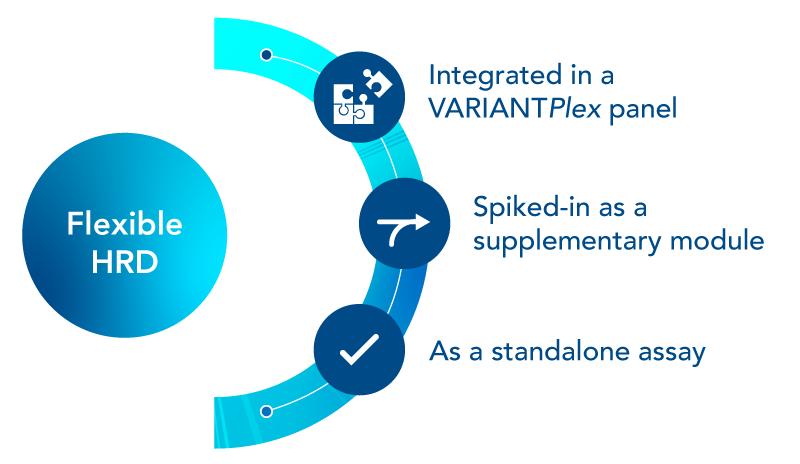Archer™ VARIANTPlex™ HRD Module
Flexible, efficient HRD assessment
Efficiently assess homologous recombination deficiency status in solid tumor samples with this HRD module designed to function as a standalone assay or as a spike-in with VARIANTPlex NGS panels.
Detect confidently with Archer VARIANTPlex NGS Panels for DNA.
Talk to a technical sales expert
Learn how the VARIANTPlex HRD Module can identify key genomic alterations for your research.
Request a consultationProduct details
Module specifications
| Specifications | |
|---|---|
| Targeted genes | - |
| Genomic alterations | HRD |
| Input nucleic acid required* | 10 ng |
| Recommended number of reads | 12 M |
| Hands-on time | < 3.5 hours |
| Total library prep time | 1.5 days |
| Platform compatibility | Illumina® |
| Reagent format | Lyophilized or liquid |
| Supported sample types | FFPE, fresh froze, cytology smear, FNA |
*Input mass requirements vary depending on type and quality. Unless the tumor cellularity and sample quality are high, 50 ng of FFPE-derived nucleic acid should be considered the minimum recommendation. If input is not limiting, 200 ng is recommended.
The VARIANTPlex HRD module can be integrated into VARIANTPlex NGS assay as a spike-in or ran as a standalone assay.
Interested in adding this module to your panel?
Customize this NGS module by adding any of our functionally-tested designs or create a new panel that fits your exact requirements with Assay Marketplace.
Benefits
- Flexible, customizable insights—Combine pre-designed panels, create custom panel content, and easily add targets to your existing assay, while maintaining high performance with minimal workflow disruption.
- Detect confidently—Anchored Multiplex PCR (AMP™) chemistry and Archer Analysis (version 7.4) uses allele‑specific copy number (ASCN) and indel information to generate a reliable HRD assessment score.
- Achieve efficiency—Streamlined workflows for your lab are enabled by a choice of reaction-sized lyophilized reagents or high-throughput liquid reagents, while parallel workflows across all Archer panels provide efficient genomic characterization.
Ready to start?
Talk with our technical sales team. Learn how the VARIANTPlex HRD Module can assess HRD in your research.
Request a consultationResources
Frequently asked questions
Can I analyze solid tumor DNA and RNA simultaneously for comprehensive genomic profiling with Archer panels?
Yes, DNA and RNA from a single sample can be analyzed with VARIANTPlex™ and FUSIONPlex™ panels to provide a genomic profile of the cancer.
For comprehensive genomic profiling, pair the VARIANTPlex Complete Solid Tumor v2 and FUSIONPlex Pan Solid Tumor v2 panels to interrogate 511 genes for SNVs, indels, CNVs, fusions, exon-skipping, and splicing variants, as well as assessment of HRD, MSI, and TMB. Additionally, the IMMUNOVerse™ TCR panel can provide tumor-infiltrating lymphocyte information relevant for solid tumor characterization. All Archer panels have parallel workflows, allowing for streamlined comprehensive solid tumor profiling.
What is the difference between Anchored Multiplex PCR (AMP™) and traditional priming methods for DNA NGS analysis?
As opposed to traditional priming methods, AMP chemistry enables tiling primers across both strands of DNA, optimally covering targeted regions for amplification and characterization of challenging, yet relevant alterations such as internal tandem duplications. Additionally, AMP chemistry uses molecular barcode adapters that bind to DNA fragments before amplification, allowing for efficient amplification of targets even from degraded or fragmented nucleic acid input, such as DNA from FFPE tissue and ctDNA from plasma.
Related products
RUO24-3031_001
